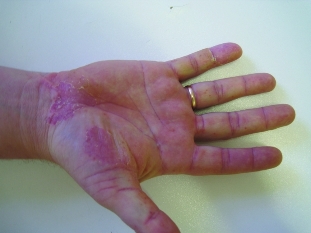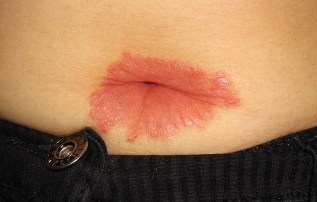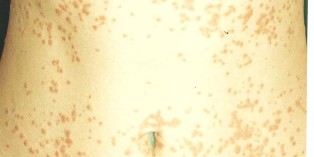Psoriasis refers to dermatoses and manifest unpleasant rash on the body. They almost did not suffer, but very itchy and look unsightly, so it gives a person a lot of inconvenience. Let us see what are the types of psoriasis, how they differ and how you can cure the disease .
The classification of psoriasis according to ICD-10

According to the international classification of diseases psoriasis L40 has code. This means that it refers to papuloscentus violations (from lat. papula - "a knot" and squama "scale").
L40.0 Psoriasis vulgaris
Other names: plaque-like. Diagnosed almost 90% of patients. Is manifested by papules scaly structure. Plaque can be gray, silver-white or pinkish color. The papules grow with time, are connected with neighboring and formed in the whole of "Islands" or "lakes".
L40.1 generalized pustular Psoriasis
Other names: pericardial, impetigo, disease Tsumbush. Is considered the most severe; manifested by vesicles or blisters filled with inflammatory substance the exudate. If the bubble breaks, and the inside will get infected, psoriasis becomes purulent. Most of these blisters occur on the hands and feet, rarely on the body.
L40.2 Acrodermatitis sustainable
Other names: Crocker dermatitis, dermatitis Settona. The contents of the pustules (pustules), which are formed in this form of psoriasis is sterile, because acrodermatitis is not an infectious disease. The main disadvantage is that plaque can form on the fingers, which can flake off the nails.
L40.3 Pustules of the palms and soles
Other names: pustular bactericide. The title is clear that this type of psoriasis affects the feet and hands. They are covered with large and small pustular formations, which gradually grow and increase in size. The contents of the pustules are sterile, but pustular bactericide is considered a severe disease. Treatment is complicated by the fact that the pustules are constantly subjected to mechanical stress (erased and reveal when walking).

L40.4 guttate Psoriasis
Manifests as small purple dots, scattered on the thighs, calves, forearms , shoulders, head, neck and back. Frequently develops after experiencing a strep throat or pharyngitis .
L40.5-7 Psoriasis arthropathic
Other names: psoriatic arthropathy, psoriatic arthritis. The disease affects about 10% of all patients with psoriasis. Affects the joints and connective tissue . Outwardly manifested by swelling of the phalanges in the hands and feet. Less frequently affects the hip, humeroscapular joints, knee joints and spine. Sometimes leads to disability: the patient can not move.
L40.8 Other psoriasis
Other names: inverse psoriasis. Appears smooth inflamed patches that almost no flakes and localized in skin folds and on the folds (groin, elbows, genitals, under the Breasts, etc.). Difficulty another treatment of psoriasis is associated with a constant friction of the affected areas, as well as sweat in the skin folds. Often inverse psoriasis is the cause of fungal infection.

L40.9 Psoriasis unspecified
This includes all other forms of psoriasis that do not fit into any of the above.
There is another division of psoriasis on the category of clinical classification.
Localization
Psoriatic plaques can spread to different parts of the body.
- The palms and soles. As has already been explained earlier, this pustular bactericide (code L40.3).
- Joints . About psoriatic arthritis also spoke (code L40.5-7).
- Mucous membranes. Eruptions appear in the oral cavity, conjunctiva and mucous membranes of the genitals. Education in the form of inflammatory elements in different forms, but with clear boundaries. Around - a small swelling.
- Nails . Scientific name: psoriatic onychodystrophy. Symptoms: indentations and grooves on the surface of nails, dullness of the nail plate, peeling, chipping, bleed through the capillaries, itching around the cuticle.
- Scalp. This type is called seborrheic psoriasis. Many people confuse it with dandruff , because one of the symptoms is the flaking of the scalp. But seborrheic psoriasis is much more unpleasant disease, because the skin crack in the area of the ears and may extend to the neck. All this is accompanied by severe itching and bruises when tearing off the scab .
- Large folds of skin or intertrigio psoriasis. Plaques are formed between the fingers, in the groin, in the armpits, under the Breasts in women.
- The surface of the body. This phenomenon is called erythroderma. A variation of this disease has a high percentage of lethal outcome because of their plaques, the skin loses its basic functions: temperature regulation, barriers, etc.
- Systemic failure is also dangerous, because it involves a combination of several types of psoriasis.
In the clinical picture
The manifestations of psoriasis are:
- ordinary (vulgar);
- exudative;
- pustular;
- arthropathic;
- in the form of erythroderma.
Psoriatic erythroderma
All the typology discussed above.
At the stage of development
If you consider psoriasis from the perspective of its staging , it is possible to allocate some stages.
Progressive psoriasis
The stage of maturation of the inflammation. Has the following features:
- education pink smooth papules;
- itching;
- inflammatory reaction after irritation papules (scratching, trying to pierce with a needle or toothpick, etc.);
- start peeling the individual elements.
Inpatient psoriasis
The stage proceeds almost without changes:
- new papules are not formed;
- old platelets do not increase in size;
- the peeling medium.
Retrogressive psoriasis

The last stage, when wounds are overgrown. Healing starts from the middle. On the former site of plaques formed white depigmented spot that does not cause discomfort, in addition to the aesthetic component.
Seasonal exacerbation
For psoriasis are characterized by seasonal recurrence. In this regard, distinguish:
- summer psoriasis: is exacerbated under the action of sunlight;
- winter psoriasis develops due to a severe cold, which affects the skin;
- off-season psoriasis: the most severe form with absence of remission periods. G Zn. the disease occurs all year.
It looks like the manifestations of psoriasis in uniform
In the area affected of the skin
In this classification only 2 types of psoriasis:
- limited is less than 20% of the skin of the body;
- distributed - more than 20%;
- universal - struck the entire skin.
The classification of the National science Foundation (USA)
Psoriasis is different and in the area affected:
- easy: lose up to 2 % of the area of the skin;
- moderate: 2-10%;
- heavy: more than 10%.
According to the international PASI
Table for calculation of the index lesions of psoriasis
PASI is represented by a number from 0 to 72 and indicates the severity of the course of psoriasis from the most mild clinical signs ( erythema and flaking) to severe (bruises, suppuration). The index is determined by experts.
The treatment of psoriasis
Modern strategy of treatment of the disease involve the use a range of methods. It is important to adhere to three main objectives:
- to achieve rapid initial positive results;
- to track the inefficiency of some methods and override them, but continue to use what helps;
- bring the patient into remission.
Among the types of psoriasis treatment are two:
- drug-free;
- medication.
Non-drug treatment
If it is possible to do without medication, doctors always try to use it. In the treatment of psoriasis significant role can be played by several factors non-pharmacological treatment.The mode of the day
People suffering from psoriasis must:
- try to quit Smoking;
- avoid alcohol (even beer);
- to wear the clothes and bed linen from natural fabrics;
- to change washing powder soap ;
- short cut nails;
- to wash only in the shower, not to visit bath and sauna;
- try to eliminate stress.
Diet for psoriasis
The positive dynamics in the treatment of psoriasis has a good effect low-protein diet that limits protein to 30 grams per day. The results show good patients who times a week doing the unloading. On this day you can eat 2-3 tomatoes, a few leaves of lettuce, 1 cucumber, 2-3 cups of green tea and 300 ml of unsweetened club soda.
General principles of diet in psoriasis mean:
- freshly squeezed citrus juices;
- fresh or steamed vegetables;
- fresh fish;
- flour only rye flour;
- dried fruit, fruit;
- nuts (not more than 50 g per day).
You should also limit or eliminate: meat, grains, meats, sugar, potatoes, cheese, beans, oils, sweets, coffee.
Spa therapy

Spa therapy is withdrawn is not the last place in the treatment of psoriasis. It is a wonderful anti-factor.
To treat psoriasis on the Dead sea .The main advantage balneotherapy: a force of nature in combating disease. Water treatment, balanced nutrition, clean air and soft sun - all this will help to reduce the symptoms of psoriasis to go in remission.
A kind of balneotherapy with varicose veins is a treatment with Garra rufa fish . These little creatures have no teeth, but their mouth, they gently eat up particles of scaly skin and improve the microcirculation of the outer skin. In addition, the procedure gives a great relaxing effect.
Physical therapy
Among the physiotherapeutic methods in the fight against psoriasis of the skin use the following:
- ultraviolet irradiation;
- selective phototherapy ;
- laser therapy ;
- radiotherapy;
- cryotherapy (treatment with cold);
- electrosleep;
- phonophoresis .
With the help of physical therapy you can achieve good aesthetic results, because almost all methods involve different types of effects on the skin outside. Plaques become smaller, the formation of healthy skin cells.
Photochemotherapy
This method is highlighted because it is one of the most effective in the treatment of psoriasis. It is used even in severe forms of the disease who do not respond well to other physiotherapeutic procedures. Photochemotherapy is exposure of the skin to long-wave UVA rays. Therefore, another name of the method - PUVA therapy (PUVA) .
Medication
Psoriasis treatment medication also helps to relieve the main symptoms and guide the patient on the road to recovery. It is possible to allocate three stages of the General (systemic) drug treatment of psoriasis:
- Emergency therapy. Is carried out in the acute period of the disease and is appointed to relieve the acute symptoms. Of drugs used are steroids and sometimes immunosuppressants .
- A transitional stage. Refers to the gradual introduction of the weaker drugs to be taken in the future, patients courses.
- Current maintenance therapy.
Drug therapy involves the application of topical treatments:
- creams;
- foams;
- gels;
- lotions;
- ointments;
- sprays.
Hormonal based ointment hydrocortisone used for psoriasis

Drugs can be purchased or made according to the recipes of traditional medicine. Funds can remain in the open air, or under an airtight dressing. The maximum effect in the treatment of psoriasis is a combination of drug and non-drug therapy. All means and methods selected by the doctor.
Conclusion
As you can see, the forms and types of psoriasis very much, and to determine what kind of disease exactly you have, is very difficult. Therefore, the appearance of primary symptoms should consult a doctor who can determine the type of psoriasis and prescribe an appropriate treatment. The earlier you begin to deal with the psoriasis, the more effective and rapid the result.























